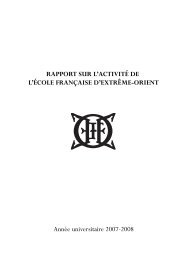Cahiers d'Extrême-Asie - EFEO
Cahiers d'Extrême-Asie - EFEO
Cahiers d'Extrême-Asie - EFEO
You also want an ePaper? Increase the reach of your titles
YUMPU automatically turns print PDFs into web optimized ePapers that Google loves.
Director of Publication<br />
Franciscus Verellen, <strong>EFEO</strong><br />
Editorial Board<br />
Paola Calanca, <strong>EFEO</strong> Taipei<br />
Elisabeth Chabanol, <strong>EFEO</strong> Seoul<br />
Luca Gabbiani, <strong>EFEO</strong> Beijing<br />
Iyanaga Nobumi, <strong>EFEO</strong> Tokyo<br />
Benoît Jacquet, <strong>EFEO</strong> Kyoto, Coordinator<br />
Lü Pengzhi, <strong>EFEO</strong> Hong Kong<br />
Advisory Board<br />
Anne Bouchy, <strong>EFEO</strong> Toulouse<br />
Alain Delissen, EHESS<br />
Jean-Pierre Drège, EPHE<br />
Bernard Faure, Columbia University<br />
Frédéric Girard, <strong>EFEO</strong> Tokyo<br />
Marc Kalinowski, EPHE<br />
Kuo Liying, <strong>EFEO</strong> Paris<br />
François Lachaud, <strong>EFEO</strong> Paris<br />
Michael Puett, Harvard University<br />
Jean-Noël Robert, Collège de France<br />
Roel Sterckx, University of Cambridge<br />
Stephen F. Teiser, Princeton University<br />
Silvio Vita, ISEAS Kyoto<br />
Editorial Offices<br />
<strong>Cahiers</strong> d’Extrême-<strong>Asie</strong> (CEA)<br />
Instructions to Authors and Guest Editors<br />
Éditions de l’<strong>EFEO</strong>: 22 avenue du Président Wilson, 75116 Paris, France<br />
<strong>EFEO</strong> Kyoto: Nihon Itaria kaikan 3F<br />
4 Ushinomiya-chô, Yoshida, Sakyo-ku<br />
Kyoto 606-8302, Japan<br />
1
Editorial Procedure<br />
Tel. +81 75 761 3946 / Fax +81 75 761 3947<br />
In addition to the main body of articles, CEA volumes generally include features such as<br />
book reviews, review articles or research notes in the overall academic and geographical<br />
field covered by the journal. Guest Editors of thematic issues are responsible for:<br />
1. The academic evaluation of the articles submitted to the Editorial Board of CEA. This<br />
evaluation must be carried out in accordance with CEA rules of peer review and in<br />
consultation with the Advisory Board;<br />
2. A first reading and editing of the articles to be transmitted to the Editorial Board<br />
when deemed ready for publication;<br />
3. Preparation of a Table of Contents of the issue;<br />
4. Writing the preface to the issue, in French and in English, titled “À nos lecteurs / To<br />
our Readers.”<br />
— These tasks must all be completed six months prior to publication<br />
The Authors of article submissions are requested to provide the Guest Editor(s) with the<br />
following additional items:<br />
Format<br />
1. An abstract in 200 words (see language requirements under “Format” below) and a<br />
list of five to ten keywords;<br />
2. A list of illustrations and their captions as a separate file (cf. “captions” below);<br />
3. A biographical notice of the author (10 lines), including his or her affiliation, main<br />
publications (two or three items), and current research projects.<br />
— The Guest Editor is responsible for assembling these items for each article<br />
CEA publishes articles in French and English. If the article is in English the abstract should<br />
2
e in French and vice versa. If assistance is required for translation, please contact the Guest<br />
Editor. Articles should conform to the following editorial guidelines:<br />
1. Articles must be in a recent version of MS Word or Nisus Writer Pro word processors.<br />
Authors are requested to avoid the use of word processing styles (“Normal,”<br />
“Header,” etc.) which interfere with CEA formatting;<br />
2. The length of articles should not exceed 9 000 words;<br />
3. The style of presentation of articles and bibliographical notices should conform to the<br />
standards of the Chicago Manual of Style for English and the Lexique des règles<br />
typographiques en usage à l’Imprimerie nationale for French;<br />
4. Footnotes should be numbered continuously;<br />
5. Bibliographical references should be in Humanities citation style (author, title, cited<br />
pages and publication information in footnotes; no bibliography). At the first<br />
occurrence, give a complete reference. In subsequent occurrences, the reference may<br />
be abbreviated.<br />
6. Continuously numbered captions should be placed where the corresponding<br />
illustrations are to appear in the text;<br />
7. Only Unicode fonts will be accepted. Authors may use three point sizes: headings (14<br />
pt); text (12 pt); quotations and footnotes (10 pt);<br />
8. Terms and names in Asian languages must be given in standard romanization (in<br />
particular pinyin for Chinese and Hepburn for Japanese), at the first occurrence, as<br />
well as the Asian language script. For names of persons, indicate dates of birth and<br />
death in parenthesis as appropriate.<br />
9. CEA uses standard Chinese characters/kanji in their traditional forms. The editor<br />
may normalize Chinese characters/kanji in accordance with editorial policy.<br />
10. Illustrations are normally published in black and white; for exceptional color images<br />
please contact the Guest Editor. Authors are responsible for obtaining copyright<br />
permissions for reproductions and the payment of copyright fees. Photographic<br />
3
eproduction of images must have a resolution of at least 300 dpi (11.6 cm / 6 inches<br />
width); they must be provided in TIFF format. For the reproduction of line drawings,<br />
a scan in TIFF format is required with a resolution of 600 dpi. The number of<br />
illustrations per article is normally limited to 10. If a larger number of illustrations<br />
are accepted, the dimensions of the images are liable to be reduced.<br />
11. The copy editing is carried out in several steps, for scholarly content, for questions of<br />
format (length of article, stylistic consistency), and possible linguistic problems,<br />
including the translation and transliteration of technical terms. The members of the<br />
Editorial Board, in collaboration with the Guest Editor and members of the Advisory<br />
Board are responsible for the copy editing process, referring to known outside<br />
contractors when necessary. Authors will be consulted for approval of the final<br />
proofs. CEA reserves the right to carry out minor editorial changes during the last<br />
stage of publication.<br />
For further information, please contact the Coordinator of the Editorial Board, Dr. Benoît<br />
Jacquet, <strong>EFEO</strong> Kyoto, at benoit.jacquet@efeo.net.<br />
4








